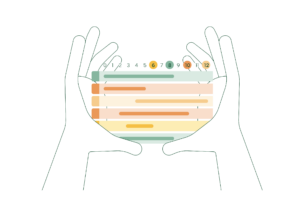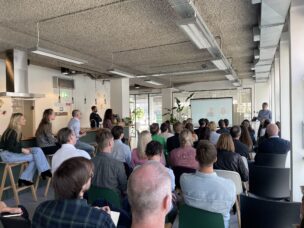the competitive advantage of using service design for digital service innovation
Since the pandemic first hit in 2020, users and customers have ever higher expectations towards the services and products they use. These expectations have grown especially because businesses and organizations had to find ways to become excellent at delivering services remotely, improving existing or adding completely new digital channels to interact with their customers and users. In fact, digital adoption has grown strongly, even among the most “digitally resistant” businesses and customers.
You might have noticed this pattern in your everyday life too. Think of your local sandwich shop turning into delivery only. Or the time when you booked a doctor appointment to be invited to a remote video consultation. Home deliveries and remote assistance have quickly gone from a convenience to a necessity, to today’s often preferred new normal.
As the benchmark rises, a holistic, customer centric view becomes increasingly important for businesses and organizations. Nowadays, it is no longer enough to measure the performance of your web site, your store, an at-home visit, or any other individual interaction. The people using a service do not think of what they are trying to achieve in these different channels, and it is time to adapt to cross-silo thinking and metrics that reflect people’s real goals. This, of course, does not mean that you should stop designing and measuring individual digital products— but instead, look at those touchpoints within the context of a greater end-to-end customer journey.
Using service design for digital innovation, provides organizations with systematic, evidence based, multidisciplinary and creative methods to unlock solutions focused on users’ needs, across different business departments and stages of the end-to-end customers journey. This way giving an approach and a methodology to design excellent products in an ever-growing ecosystem of digital services.
let’s start from a quote
“To a user (or customer!), a service is simple. It is something that helps them to do something – like learn to drive, buy a house, or become a childminder. It is an activity that needs to be done. A verb that comes naturally from a given situation, that cuts across transactions, call centre menus and around advisors, towards a customer goal.”
– Lou Downe
For an organization or a business, services are composed of a variety of departments, infrastructure, IT, communication systems and channels of interactions with the customers. Each of those governed by a myriad of policies, guidance, brand documents, supporting systems and so forth…
The orchestration of actions performed by of all these organizational parts can often be complex and fragmented. It is hard to keep track of all that is happening behind the scenes of an organisation! Yet, like a butterfly flapping its wings and causing a typhoon, every business action has an impact on the experience of the customers – or end users.
A service design perspective has the strategic aim of bringing together the needs of the customers together with the internal business requirements. Having a birds-eye view of a service while designing products allows to connect these two often competing aspects. The main opportunity of service design is to help businesses meet and exceed the needs of customers whilst remaining competitive.

the customer experience journey does not equal the sum of its parts – and its digital products
To truly measure the success of your digital products, it is vital to take a service perspective and not look at touchpoints or interactions in isolation.
Working in a digital team making products requires measuring the success of such products. The challenge is that measuring business success goes beyond each individual tool, system or channel of interaction with your customers.
Think of a customer going through a new onboarding experience of a media company. This might on average span across many months, involving various phone calls, home visits from technicians and numerous web and mail interactions. Research has shown that, despite each interaction consistently scoring over 90% positively, in the end-to-end journey the satisfaction drops down to 40 percent lower.
That is why designing digital products in isolation is not enough anymore! To manage competitors and customer expectations these days, it is important to begin by defining the service experience you want to deliver, and then orchestrate your organisation with that aim in mind.
Having a clear idea of where customers and staff show up, interact with each other and exchange information by using different tooling, products or features is one of the key benefits of a service design approach and allows to:
- spot challenges and opportunities for improvements on how to simplify customer journey experience across different channels and departments,
- simplify complexity, avoiding repetitions and the risks of siloed products and data. This way really leveraging the interconnection of your systems in use.
- and of course, measure success of your multitude digital products across one customer journey.
the 3 ingredients of service design
Service blueprints, customer journeys, needs based profiles, empathy maps…ever heard of any of these? To understand what it means to use service design for digital service innovation, let me start from the very basics. Below are three foundational concepts that all service design methodologies and tooling are based on. Having a good understanding of the concepts below is key in reaching business outcomes.
Movement
All customers must move through phases and stages of a service to get the value from it. In customer journeys for example, there is a time-based dynamic to a service. And like stories, services have a before, a beginning and an after. Where does the customer come from (entry point or trigger)? How long does it take for them to move across the service end-to-end and how do they enter back, if they want to?

Structure
The structure in a service consists of the orchestration of channels employed (like digital or face to face interactions) and the business architecture that the service is built upon. This also includes tooling, staff that deliver the service, and of course the end users of the service.
A service design approach helps defining this complex and dynamic information by visualizing it. Giving it structure. Take service blueprints for example. In blueprints information is laid out across rows (typically people or company departments) and columns (typically defining actions and steps in the process).

Behaviour
Movement and structure provide a framework for understanding and designing services. What happens in reality is far messier. Behaviour is what happens at the intersection of movement and structure. How do customers behave in different channels? How do they behave in different situations or in various stages of their life? Once we can influence behaviours through design, we can really start to impact business performance. From the analysis of qualitative and quantitative behavioural data it is possible to understand the true cause of challenges, bottlenecks, as well as true aspirations, desires, and latent needs. In the behaviour lie opportunities for the service providers to better engage with their customers.

business solutions over product solutions
The real value and competitive advantage of service design for digital innovation, and the perspective it can bring to the process of designing digital services, is to provide you with customer-centred business solutions over product solutions.
After all…
“People do not want to buy a quarter-inch drill (product), they want a quarter-inch hole (the real need to address)”
– Theodore Levitt
If you are curious about seeing service design-led projects and practical methods, check-out the blogposts below:
- Read more about the three ingredients of service design in our blogpost about customer journey mapping.
- Read more about behaviour analysis in our blogpost about customer research.
- Read about innovative about embedding a customer-centred approach in our blogpost about ways of working.
Want to stay updated on our events regarding service design? Fill in the form below and we’ll keep you posted!











